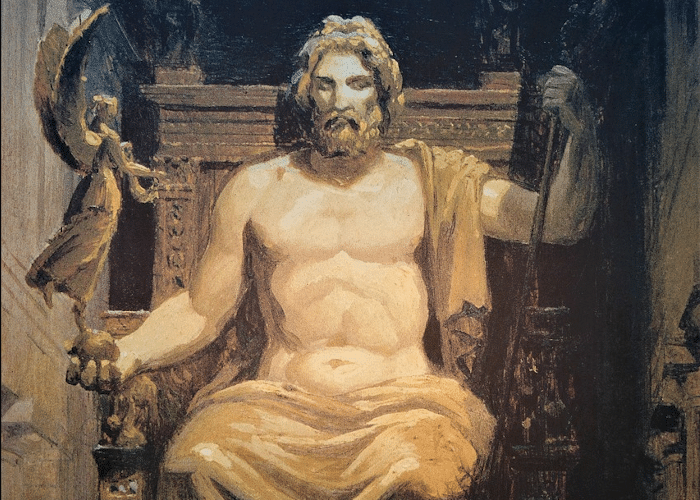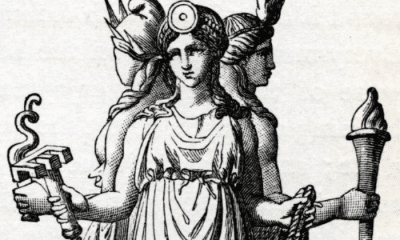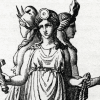
Greek
Who Was the Son of Zeus and Europa?
Who Was the Son of Zeus and Europa?
Europa was famously abducted by a white bull, but did you know that her son by Zeus played an even bigger role in mythology?
Zeus was as well-known for his many affairs with both mortal women and goddesses as he was for his role as king of the Olympians. Often, he used tricks and disguises to win over his mistresses.
One of the most famous examples of this is the abduction of Europa. Zeus disguised himself as a gentle white bull and swam across the sea with the Phoenician princess when she climbed onto his back.
He took her to the island of Crete, where she gave birth to three of his sons. Sarpedon and Rhadamanthus were minor figures in Greek mythology, but her eldest son appears often in the ancient legends.
King Minos is considered to be the founder of Crete and features in virtually every myth set on the island. Often painted as a tyrant by the Greeks, there is evidence that this is due to old historic grudges.
Minos gave his name to the Minoan culture, which predated the Mycenaean and the rise of the Greek states. In the pre-Greek period, archaeology tells us the Minoans held power over many of their neighbors.
Was Minos a historical king, and if so did he really demand human sacrifices from the people of Athens? We may never know the details of such ancient history, but the stories of Europa and Zeus’s son can help shed light on a mysterious culture.
The Sons of Zeus and Europa
Europa was one of the many human lovers of the king of the gods, Zeus. The image of her abduction by the god is one of the most famous of the ancient world.
In order to get close to the Phoenician princess, Zeus disguised himself as a white bull and blended into her father’s herds. Europa was intrigued by the beautiful and gentle bull and eventually climbed up on his back.
When she did so, Zeus took off. As Europa clung to his horns he swam across the sea and to the island of Crete.
Once they arrived in Crete, Zeus presented his new mistress with wondrous gifts and set her up for a comfortable life.
Together, they had three sons: Minos, Rhadamanthus, and Sarpedon.
Europa eventually married a local king, Asterion, who raised her sons as if they were his own. When he died, he left his throne to the eldest son, Minos.
Minos and Sarpedon quarrelled over power, and when Minos won the fight he banished his brother from Crete. Sarpedon fled to Lycia, in what is now Turkey, and became king there.
Minos and Rhadamantus shared power for a time, but the older brother soon grew jealous of his sibling’s popularity among the people. Rhadamanthus either left Crete or was driven into exile, and settled in the Greek region of Boeotia.
There, he married a widowed Mycenaean princess named Alcmene. Rhadamanthus became the stepfather of his half-brother, Heracles.
The most famous of the three, however, was Minos. The legendary founding king of Crete was so closely associated with the island that the pre-Greek culture that existed there is still called Minoan by archaeologists after him.
Minos built a great palace at Knossos and built Crete into a powerful kingdom. The island nation conquered much of mainland Greece, including Attica and the city of Athens.
Minos proved to be an arrogant king, however. When gifted with a white bull by Poseidon he chose to keep the animal instead of sacrificing it to the sea god and set off a disastrous series of events.
Poseidon caused the Cretan Bull to go mad and terrorize the people of the island. Even worse, he made Minos’s wife fall in love with the wild beast.
As a result she gave birth to the Minotaur, the bull-headed cannibal. Minos had the Labyrinth built to contain his wife’s monstrous son and demanded young men and women to be sent from Athens to sacrifice to its terrible appetite.
Theseus killed the Minotaur and the Cretan Bull was eventually captured by Heracles, restoring peace to Crete. But Minos would appear in many more stories.
He tried to force the seer Polyidus to teach his son, Glaucus, the art of divination. He conquered many more lands in Greece despite the monsters that terrorized his homeland.
Minos eventually died when trying to track down the inventor Daedalus. The architect of the Labyrinth and his son had been imprisoned on Crete but had escaped by constructing wings of feathers and wax.
Minos tracked Daedalus to Camicus, Sicily. The king there had Minos boiled alive in a bath rather than hand over the famous inventor.
The story of Zeus and Europa’s sons did not end there, however. The three legendary kings retained positions of prominence in the afterlife.
Seeking to make the way souls were judged after death more fair, Zeus decided to assign three human judges to determine their worth. Minos and Rhadamanthus were given the task, along with King Aeacus of Aegina.
Rhadamanthus judged the souls of people from Asia while Aeacus judged those from Europe. In case of an uncertain judgement, Minos cast the deciding vote.
My Modern Interpretation
The stories of Europa and Minos are among the most ancient in the Greek world.
Little is known about the religious beliefs of the pre-Greek Minoan culture, as their writing has never been translated. It is widely supposed, however, that many of the stories of the legendary King Minos came from this forgotten faith.
The name Minos is thought to come from a Cretan title for kingship. Rather than being an individual ruler, the mythical Minos was representative of all the kings of the island of Crete.
Archaeological evidence shows that the Minoan culture did take control of much of the Greek mainland. While the cities and states named in later mythology had not reached their height, the area of what was later Athens was among those that has evidence of Minoan influence.
It is believed by many that the story of Theseus and the Minotaur has elements of history interwoven with the mythical aspects of it. It is possible that young people of Athens were sent to the island of Crete as tribute.
Bulls are thought to have played an important part in Minoan religion based on art and iconography found at the archaeological site of Knossos. This explains the prevalence of bulls in the Greek myths that took place on the island, and it is even possible that captives from Athens were once sacrificed in the name of the bull god.
There is some evidence that the Minoan bull god may have been an early form of Poseidon based on that god’s connection to the mythology of Minos. The bull that abducted Europa may have once been imagined to be Poseidon rather than his brother.
The story of Europa’s abduction by a god in the form of a bull also has links to myths of the Levant. This area was also said to be the princess’s homeland, giving further credence to the idea that the myth was adopted from a foreign source.
These myths portray not the kidnapping of a human princess, but the marriage between a bull god and a goddess. Later sources identified this goddess as Astarte, the moon goddess of the Phoenicians and other Middle Eastern cultures.
Of course, there is another possibility for the introduction of the Phoenician princess to the founding legend of Crete. Some rationalizations suppose that Europa was a real woman who was kidnapped by invading Minoans and taken back to their island as a captive.
The end of Minos’s story seems puzzling based on the mythology surrounding him. The king was noted for making bad decisions in life, but in death became the chief judge of the souls of the deceased.
Minos was portrayed much differently in Crete than he was in the rest of the Greek world, however. Perhaps as a result of ancient grudges, the character was villainous in Athens but revered in his homeland.
The people of Crete remembered Minos as a wise king who brought peace to his land. He protected the coastline and merchants from pirates, established trade throughout the region, and ruled his people justly.
The Minos remembered in his own country was a much more worthy judge of the dead than the villain he was thought to be in Athens.
In Summary
Europa was a Phoenician princess who was abducted by Zeus. In the form of a white bull he took her across the sea to the island of Crete.
There, she bore him three sons. Sarpedon became a ruler in Asia Minor while Rhadamanthus married Alcmene in Boeotia.
The most famous, or infamous, of the three was Minos. Inheriting the throne of Crete from his stepfather he became king of the island nation.
Minos is usually depicted in Greek mythology as a despotic ruler. His insults to the gods resulted in the birth of the Minotaur and the sacrifices of young men and women from Athens.
Despite making several cruel and foolish decisions in life, Minos was given the role as chief judge of the dead in the underworld. This makes little sense in the Athenian legends, but on Crete itself he was remembered as a wise and just king who brought prosperity to the island.
The stories of Europa and Minos appear to be rooted in both ancient history and foreign mythology. Europa’s abduction by the bull links the Middle Eastern princess to the religion of that region, giving credence to the idea that the story itself originated from Phoenicia.
The legends of King Minos appear to be based more in history than ancient myth. Minos is believed to be an ancient word for kingship in the culture of ancient Crete, which is called the Minoan after him.
Archaeological evidence shows that the Minoans established themselves as an economic and possibly military power in early Greece, and may have demanded Athenian youths in tribute.
While little is known about Minoan mythology, artistic evidence and the prevalence of bulls in stories of the island lead historians to believe that the animals played a role in the Minoan religion.
The son of Zeus and Europa was remembered as a foolish villain in stories that originated in Athens. But stories told on Crete and the evidence available to historians paint a picture of a more just and influential leader.



